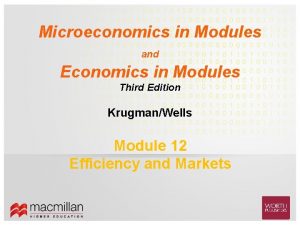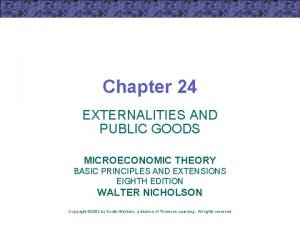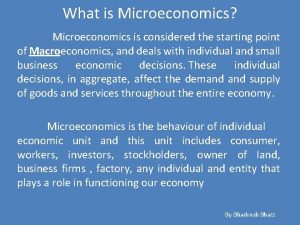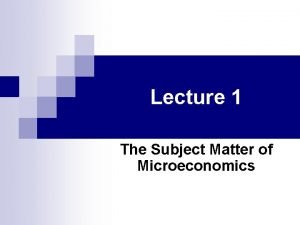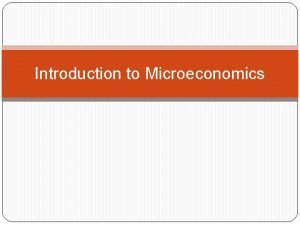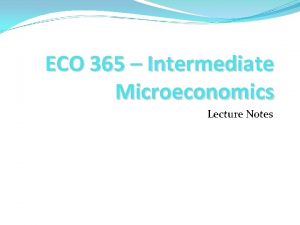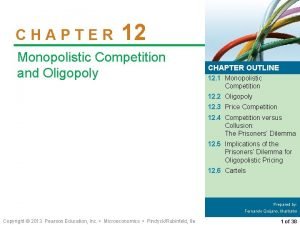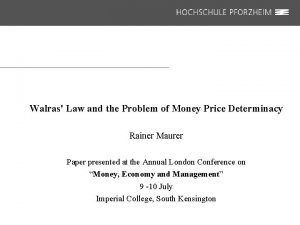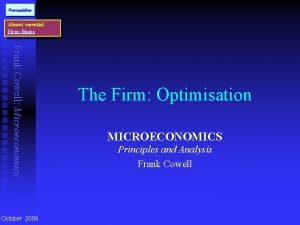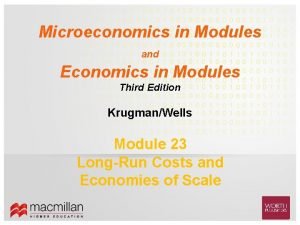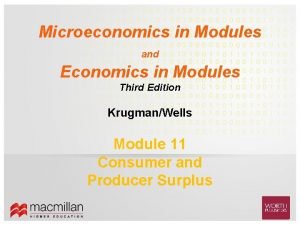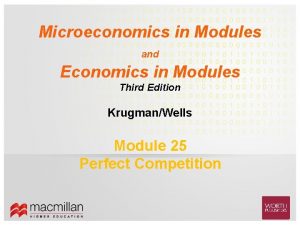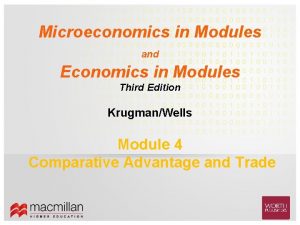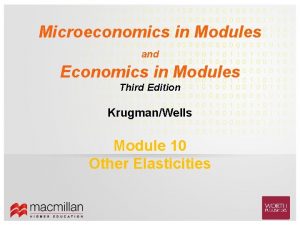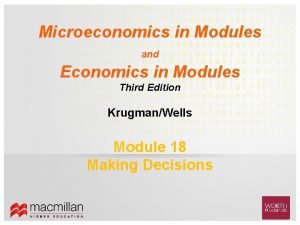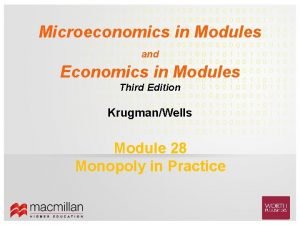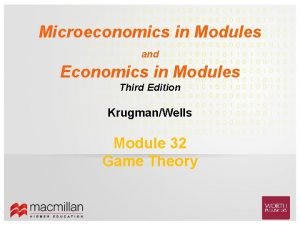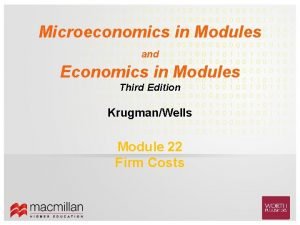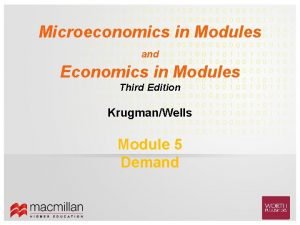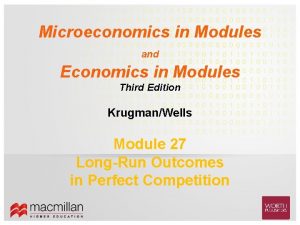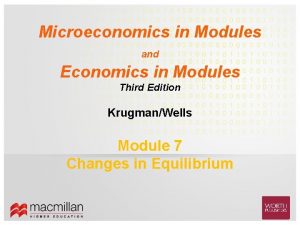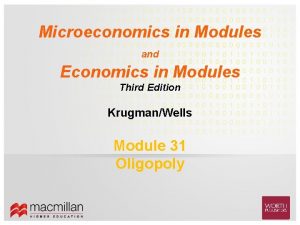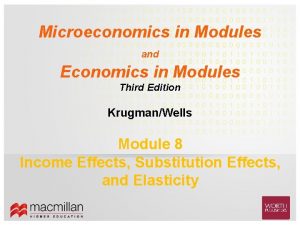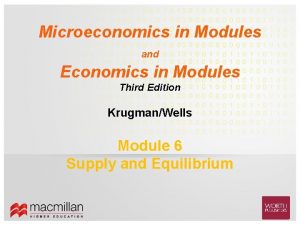Microeconomics in Modules and Economics in Modules Third

















- Slides: 17

Microeconomics in Modules and Economics in Modules Third Edition Krugman/Wells Module 1 The Study of Economics

What You Will Learn 1 How scarcity and choice are central to the study of economics 2 The importance of opportunity cost in individual choice and decision making 3 The difference between positive economics and normative economics 4 When economists agree and why they sometimes disagree 5 What makes macroeconomics different from microeconomics

Individual Choice: The Core of Economics • Individual choice is the decision by an individual about what to do, which necessarily involves a decision about what not to do. 3 of 18

Individual Choice: The Core of Economics • Principles behind the individual choices include the following: 1) Resources are scarce. 2) The real cost of something is what you must give up to get it. 3) “How much? ” is a decision at the margin. 4) People usually take advantage of opportunities to make themselves better off. 4 of 18

Individual Choice: The Core of Economics • Principles behind the individual choices include these facts: – Resources are scarce. – The real cost of something is what you must give up to get it. 5 of 18

Resources Are Scarce • A resource is anything that can be used to produce something else. – Ex. : Land, labor, physical capital, human capital • Resources are scarce—the quantity available isn’t large enough to satisfy all productive uses. – Ex. : Petroleum, lumber, intelligence 6 of 18

Opportunity Cost: The Real Cost of Something Is What You Must Give Up to Get It • The real cost of an item is its opportunity cost: what you must give up in order to get it. • Opportunity cost is crucial to understanding individual choice. 7 of 18

Economics in Action Got a Penny? • Sixty years ago, a penny was equivalent to 30 seconds’ worth of work—it was worth saving. • Wages have risen along with overall prices. Today a penny is therefore equivalent to just over 2 seconds of work—and so it’s not worth the opportunity cost of the time it takes to worry about a penny more or less. • The rising opportunity cost of time in terms of money has turned a penny from a useful coin into a nuisance.

Macroeconomics versus Microeconomics • Microeconomics focuses on how decisions are made by individuals and firms and the consequences of those decisions. 9 of 18

Macroeconomics versus Microeconomics • Macroeconomics examines the aggregate behavior of the economy. • Macroeconomics examines how the actions of all of the individuals and firms in the economy interact to produce a particular level of economic performance as a whole. – In macroeconomics, the behavior of the whole macroeconomy is indeed greater than the sum of individual actions and market outcomes. 10 of 18

Macroeconomics versus Microeconomics Let’s begin by looking more carefully at the difference between microeconomic and macroeconomic questions. MICROECONOMIC QUESTIONS Go to business school or take a job? MACROECONOMIC QUESTIONS How many people are employed in the economy as a whole? What determines the salary offered by Citibank to Cherie Camajo, a new Columbia MBA? What determines the overall salary levels paid to workers in a given year? 11 of 18

Macroeconomics versus Microeconomics MICROECONOMIC QUESTIONS MACROECONOMIC QUESTIONS What determines the cost to a university or college of offering a new course? What determines the overall level of prices in the economy as a whole? What government policies should be adopted to make it easier for low-income students to attend college? What government policies should be adopted to promote full employment and growth in the economy as a whole? What determines whether Citibank opens a new office in Shanghai? What determines the overall U. S. trade with the rest of the world in goods, services, and financial assets? 12 of 18

Positive versus Normative Economics • Positive economics is the branch of economic analysis that describes the way the economy actually works. • Normative economics makes prescriptions about the way the economy should work. 13 of 18

When and Why Economists Disagree There are two main reasons economists disagree: • Which simplifications to make in a model • Values 14 of 18

Economics in Action • Many economists agree on their responses to statements such as “Tariffs and import quotas usually reduce general economic welfare” and “A ceiling on rents reduces the quantity and quality of housing available. ” • What is interesting is that many noneconomists disagree with economists on these statements.

Summary 1. Everyone has to make choices about what to do and what not to do. Individual choice is the basis of economics. 2. The reason choices must be made is that resources— anything that can be used to produce something else—are scarce. 3. Because you must choose among limited alternatives, the true cost of anything is what you must give up to get it— all costs are opportunity costs. 4. Macroeconomics is the study of the behavior of the economy as a whole. Macroeconomics differs from microeconomics in the type of questions it tries to answer and in its strong policy focus.

Summary 5. Economists use economic models both for positive economics, which describes how the economy works, and for normative economics, which prescribes how the economy should work. 6. There are two main reasons economists disagree. One, they may disagree about which simplifications to make in a model. Two, economists may disagree—like everyone else—about values.
 Economics modules
Economics modules Odontoclasia definition
Odontoclasia definition Senile carious lesions
Senile carious lesions Economics and business economics maastricht
Economics and business economics maastricht Oxford fajar
Oxford fajar Pure public good
Pure public good Objectives of macroeconomics
Objectives of macroeconomics Definition of macroeconomics
Definition of macroeconomics Non mathematical economics
Non mathematical economics What is microeconomics
What is microeconomics What is the subject matter of microeconomics
What is the subject matter of microeconomics Importance of microeconomics
Importance of microeconomics Intermediate microeconomics lecture notes
Intermediate microeconomics lecture notes Intermediate microeconomics notes
Intermediate microeconomics notes Cartel microeconomics
Cartel microeconomics Walras law
Walras law Almost essential
Almost essential Parkin macroeconomics 13th edition pdf
Parkin macroeconomics 13th edition pdf
